
Rheden is a municipality and a town in the eastern Netherlands.

Amerongen is a town in the municipality of Utrechtse Heuvelrug in the province of Utrecht, Netherlands, on the border of the Utrecht Hill Ridge. It lies about 7 km southwest of Veenendaal.

Heemskerk is a municipality and a town in the Netherlands, in the province of North Holland. It is located in the Kennemerland region.

St. Martin's Cathedral, Utrecht, or Dom Church, is a Gothic church dedicated to Saint Martin of Tours, which was the cathedral of the Diocese of Utrecht during the Middle Ages. It is the country's only pre-Reformation cathedral, but has been a Protestant church since 1580.

Muiden Castle is a castle in the Netherlands, located at the mouth of the Vecht river, some 15 kilometers southeast of Amsterdam, in Muiden, where it flows into what used to be the Zuiderzee. It is one of the better known castles in the Netherlands and featured in many television shows set in the Middle Ages.

Huis Doorn is a manor house and national museum in the town of Doorn in the Netherlands. The residence has early 20th-century interiors from the time when former German Emperor Wilhelm II resided there (1919–1941).

The Sparta Stadion, nicknamed Het Kasteel, is a football stadium in Rotterdam, Netherlands. It is the home ground of Sparta Rotterdam. It has a capacity of 11,026.

A rijksmonument is a national heritage site of the Netherlands, listed by the agency Rijksdienst voor het Cultureel Erfgoed (RCE) acting for the Dutch Ministry of Education, Culture and Science.

De Haar Castle is located outside Utrecht, Netherlands. It is the largest castle in The Netherlands.

Brederode Castle, also called the Ruins of Brederode, is located near Santpoort-Zuid. The castle was founded in the second half of the 13th century by William I van Brederode (1215–1285). William was a descendant of the lords van Teylingen, who were related to the counts of Holland. The castle formed part of the high lordship Brederode, which had been given in loan in the 13th century to the lords of Brederode by the count of Holland.

The Burcht van Leiden is an old shell keep in Leiden constructed in the 11th century. It is located at the spot where two tributaries of the Rhine come together, the Oude Rijn and the Nieuwe Rijn. The structure is on top of a motte, and is today a public park.

Grote or Sint-Laurenskerk is a landmark formerly Protestant church in Alkmaar, Netherlands, now in secular use. The building is located on the Koorstraat. It is mostly closed in the winter and open for tourists in the summer months or by appointment.

Elswout is a historical buitenplaats dating from the 19th century in a park by the same name in Overveen, Netherlands.

Gunterstein Castle is a castle in Breukelen, on the river Vecht, that was the former home of the rich Dutch widow Magdalena Poulle (1626–1699). She bought the property and associated title after the former castle and stronghold was destroyed by the French in the Disaster Year Rampjaar 1672.

The Wijnkopersgildehuis is a former guildhall in Amsterdam. The 17th-century double house is located at Koestraat 10–12, near Nieuwmarkt square. It is one of the few remaining guildhalls in Amsterdam and has the oldest known neck-gables. The building has rijksmonument status.

Ter Worm or Terworm Castle is a castle located in the municipality of Heerlen, Limburg Province, Netherlands. The castle is part of the Terworm estate.

The post office in De Steeg is a monumental building located on Hoofdstraat 21 in De Steeg, Rheden, the Netherlands. It was built in 1905, by order of count Bentinck, based on a design by G. J. Uiterwijk. Due to the noticeable style, which resembles timber framing, the building and a nearby barn were made a rijksmonument on June 15, 2001.

De Steeg is a Dutch village within the municipality of Rheden. Due to its central location within the municipality, it houses the town hall.

Cannenburg Castle or Cannenburch Castle is a castle with a moat in the Netherlands. It is situated in Vaassen, a town in the province of Gelderland.
Huize Ivicke is a monumental building in Wassenaar, the Netherlands. Constructed in 1913 for A. F. J. van Hattum, it is a replica of the Eremitageslottet hunting lodge in the Jaegersborg Dyrehave in Denmark. It was inhabited until the mid-1980s, when it became offices. Since 2000, it has been owned by speculator Ronnie van de Putte, known as the "Slum King of the Netherlands". He refuses to renovate the building, despite its monumental status. Heritage groups warned the local municipality in the late 2010s that the villa was severely dilapidated and it was placed on a list of the fourteen most threatened monuments in Europe. It is currently the subject of an intense dispute over emergency renovations and was squatted in 2018, by people wanting to carry out essential repairs. The house, the formal garden, the gate and the playhouse are all national monuments.





















